Complex particles in complex flows (MSc/BSc)

The study of the transport of particles in turbulent flows have attracted significant interests in recent years. Yet many questions remain unanswered. We offer the possibility to investigate the dynamics of particles with simple or complex shapes, as well as with diverse physical properties, in turbulent flows. The student will employ in-house developed codes (Lattice Boltzmann and Pseudo Spectral) for the Direct Numerical Simulation (DNS) of turbulent flows with point-like and/or finite-size particles. The student analyse the statistical properties associated with particle dynamics, as well as the influence that particles exert on the fluid itself.
Federico Toschi
Contact: Federico Toschi
Convection under variable rotation (BSc/MSc)
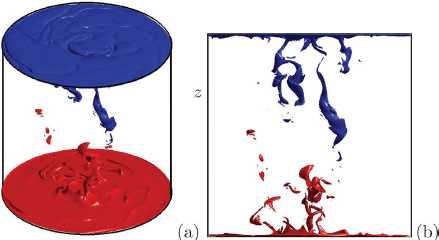
It is quite well-known that rotation affects the heat transfer between two plates at different temperatures, because the background rotation changes the nature of the turbulent flow. When the rotation speed Ω of the container is modulated, the flow and the heat transfer show a number of intriguing phenomena (like a growth and oscillating behavior of the Nusselt number, followed by a complete collapse) that are still not understood. Further numerical simulations and/or experiments are needed to unravel these phenomena.
Rudie Kunnen, GertJan van Heijst
Contact: Rudie Kunnen
How to fly a drone in turbulence? (MSc)
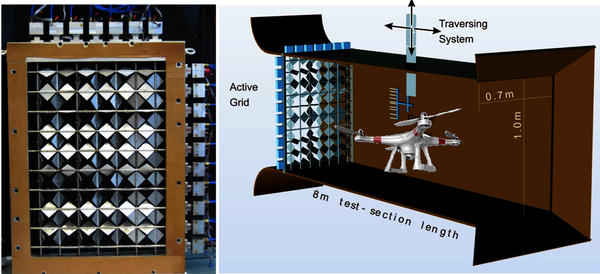
Measurements of atmospheric turbulence involve either the positioning of fixed probes on towers or flying probes mounted on airplanes. Here we want to investigate if drones could potentially be used as more flexible instruments to investigate atmospheric turbulence from inside the flow. Drones come in different sizes and, particularly the smaller ones, can be strongly affected by turbulent fluctuations, even at the smaller scales.
The question is whether we can use a small drone as a probe of atmospheric turbulence, for example by studying the signals of its accelerometers. The other question is how to design drone software so that it can cope more effectively with turbulence. We will use the TU/e wind tunnel which has a unique facility to generate "tailored" turbulence using a computer-controlled active grid.
In this project you will learn about the fundamental properties of turbulent flows, boundary layers, experimental techniques for fluid dynamics research, including the programming of active grids, the running of wind tunnels and …. drones flying.
Contact: Federico Toschi
Interaction between a drone and a wall (Graduation- or BEP project)
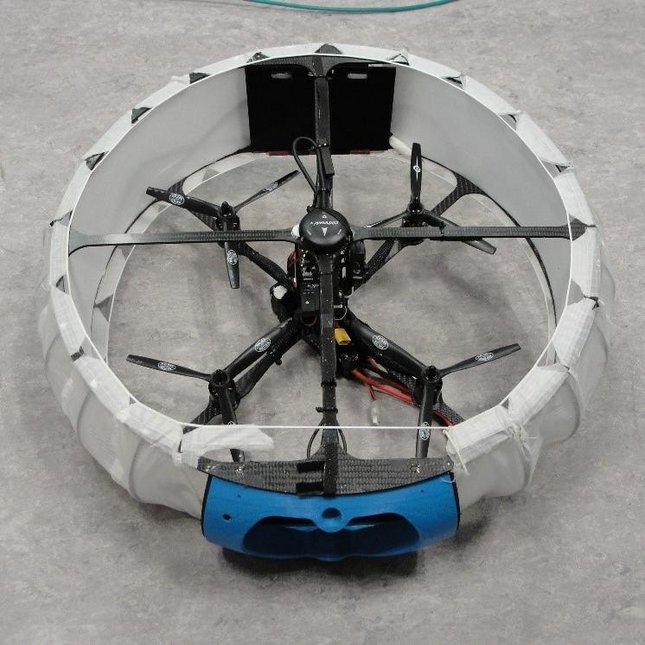
TU/e student team Blue Jay develops drones for societal, medical, safety and human interaction applications. Inside buildings the proximity of walls makes flying risky as a drone with a protective outer shell tends to “suck” itself towards a wall when it comes too close.
Blue Jay likes to know how the design of the outer shell and/or propellers can eliminate this problem.
We have a research set-up available on which a drone can be mounted and where the lateral forces on a drone can be measured. In this way the effect of walls and ceiling under various boundary conditions can be investigated.
Objectives
- measure the effect of the airflow between a drone and a wall on the lateral forces
- determine the effect of the outer (safety) shell on the flight behaviour
- study effects of ceiling
- generate solutions to improve flight behaviour
Approach
- start form an experimental basis, to understand the phenomenon
- parallel numerical computation using 2D Comsol simulations
This project is intended as a 45-60 ECTS graduation project, or as BEP project.
Contact: Jos Zeegers
Magnetic Density Separation and Moving Wall effects (MSc)

We are involved in an NWO-Perspectief project on Magnetic Density Separation (MDS) technology for recycling plastic. MDS uses fluid mechanics and magnetic fields to separate plastic and this technology can contribute to a cleaner planet.
For the flow in an MDS machine the level of turbulence has to be as small as possible to have the highest separation efficiency. Laminator honeycombs are used to streamline the flow in real MDS machines. Besides this a running belt is applied to establish moving wall influences.
Investigations are made in a wind tunnel TRIPLE duct replica of an MDS machine to study the downstream flow using Laser Doppler Velocimetry (LDV). The replica includes also a running belt to simulate moving walls. Effects of belt speed, generation of vortices, and Kelvin Helmholtz type of instabilities will be investigated via independent control of belt speed and side channel flow rate.
Objectives
- Measurements of flow instabilities in a merging mixing layer
- Effects of moving walls
- Turbulence decay
Approach
- Using a TRIPLE wind tunnel with moving walls
- Learning and using 3D Laser Doppler Velocimetry
The project is intended as a 45 or 60 ECTS graduation project for a master student.

Contact: Jos Zeegers
Magnetic Density Separation and Turbulence

The Fluids & Flows group investigates Magnetic Density Separation (MDS). This project is a cooperation between our university, NWO and the industry (Umincorp). MDS is used to separate plastic waste based on its density and is a novel technology for plastic recycling.
Plastic particles are injected in a magnetic fluid, downstream of a flow laminator and while transporting them through a magnetic zone, plastic particles will float at a stable height, dependent on their density. In this way plastic particles can be separated. MDS is a key technology to recycle plastic automatically and is also relevant for the worldwide development of a more sustainable society.
In order to separate the particles with optimum separation efficiency, the flow in the magnet zone should be as calm as possible, but this is difficult because there is a continuous flow, and even under ideal circumstances using a laminator system, vortex motion and turbulence are created in the injection zone.
We aim to investigate the effect of turbulence on the separation efficiency of the MDS machine. The investigations will be carried out experimentally using Particle Image Velocimetry (PIV) in a wind tunnel by using a replica of the flow laminator of a real MDS machine. This is possible because of the hydrodynamic similarity laws. The measurements will be validated with a numerical code.
Objectives
- Measurements of turbulence downstream of laminators
- Identification of critical parameters
- Numerical validation of the measurements
Approach
- Using a wind tunnel which is in operation
- Learning PIV technique

Contact: Jos Zeegers
Magnetic Density Separation and Turbulence by Honeycomb Laminators (MSc)

The Fluids & Flows group investigates Magnetic Density Separation (MDS). This project is a cooperation between our university, NWO and industry (Umincorp). MDS is a novel technology to separate different types of plastic based on their mass density.
Plastic particles are injected in a magnetic fluid, downstream of a flow laminator and while transporting them through a magnetic field, the particles will float at a stable height, dependent on their density. In this way plastic particles can be separated. MDS is a key technology to recycle plastic and therefore relevant to obtain a more sustainable society.

The laminator is a key component in the MDS machine and consist of honeycombs that streamline the flow. The effect of the near flow field downstream of the honeycomb was already investigated in a small wind tunnel. In the current project we aim to investigate the turbulence level far downstream of the laminator. In order to make this possible, large honeycomb systems have been constructed for the large Cascade wind tunnel facility.
With Hot Wire measurement techniques, we aim to measure the development of the turbulence and spectral components behind the honeycomb and determine its scaling behaviour to improve MDS.
Objectives
- Measurements of honeycomb turbulence
- Identification of near and far wake
- Numerical validation (if possible)
Approach
- Using a large wind tunnel facility
- Learning and using Hot Wire measurement technique
- Perform DNS of turbulent flow
The project is intended as a 45 or 60 ECTS graduation project for a master student.
Contact: Jos Zeegers
Rotating convection in a cylinder: the wall circulation (BSc/MSc)
Rotating turbulent convection is a simple model for many large-scale flows in nature, such as the atmosphere and the oceans, but also the interior of stars and planets. Experiments on this flow have to introduce confinement; typically a cylindrical geometry is used. We have recently observed that a strong circulation flow is formed near the sidewall. We want to know more about this circulation , which can be studied most easily using numerical simulations.
Contact: Rudie Kunnen
Ventilation flow (BSc/MSc)
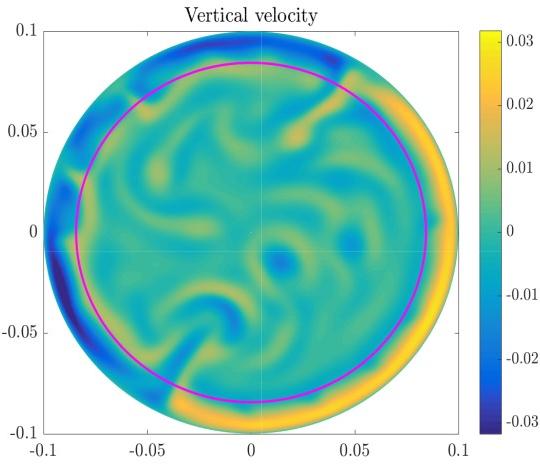
Ventilation flows are important for keeping a healthy indoor environment by removing for example pollutants in an efficient way. One way to enhance the ventilation efficiency of such flows is by making them time-dependent. Recent computational fluid dynamics (CFD) simulations suggest that the air exchange efficiency for an enclosure that is ventilated by a time-varying in- and outflow can be much higher than for a steady ventilation flow. The present project (Bachelor or Master) aims to better understand enhanced ventilation efficiency for time-dependent flows using concepts from dynamical system theory combined with two-dimensional direct numerical simulation (DNS) of incompressible flows in a rectangular enclosure with an in- and an outflow opening.
Leon Kamp, GertJan van Heijst, Twan van Hooff (fac B)
Contact: Leon Kamp
Vortex flow measurement in plasma reactor (MSc)
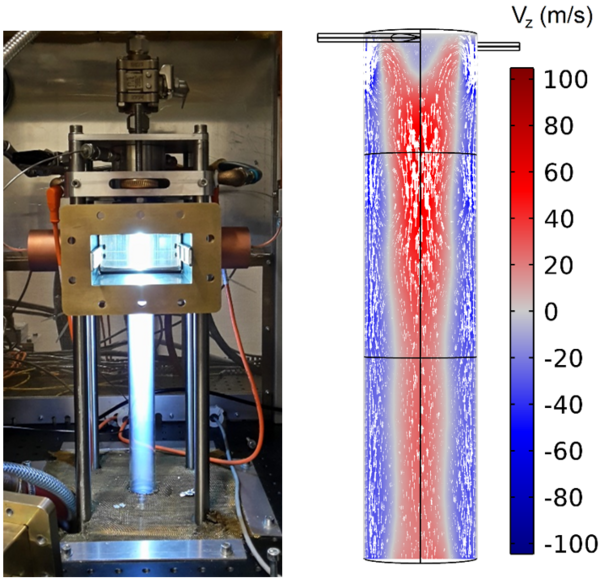
The Solar Fuels division at DIFFER researches methods to efficiently produce synthetic fuels using renewable sources of electricity. Chemical conversion using electricity is considered as a viable method for storage and transport of renewably generated energy and a pathway towards integrating sustainable electricity into the chemical industry. In the DIFFER PSFD group, the central topic in Solar Fuels research is the dissociation of the CO2 molecule using plasma processing. The CO2 vortex flow stabilizes the plasma in the center of the reactor tube and plays a crucial role in the transport of CO from, and CO2 to, the plasma region. The aim of this project is to do PIV measurements on vortex gas flow, that is comparable to flows used in the plasma reactors. Moreover, these measurements are used to validate the CFD models that currently help to understand the flow behaviour, and improve the reactor design.
Contact: Rudie Kunnen